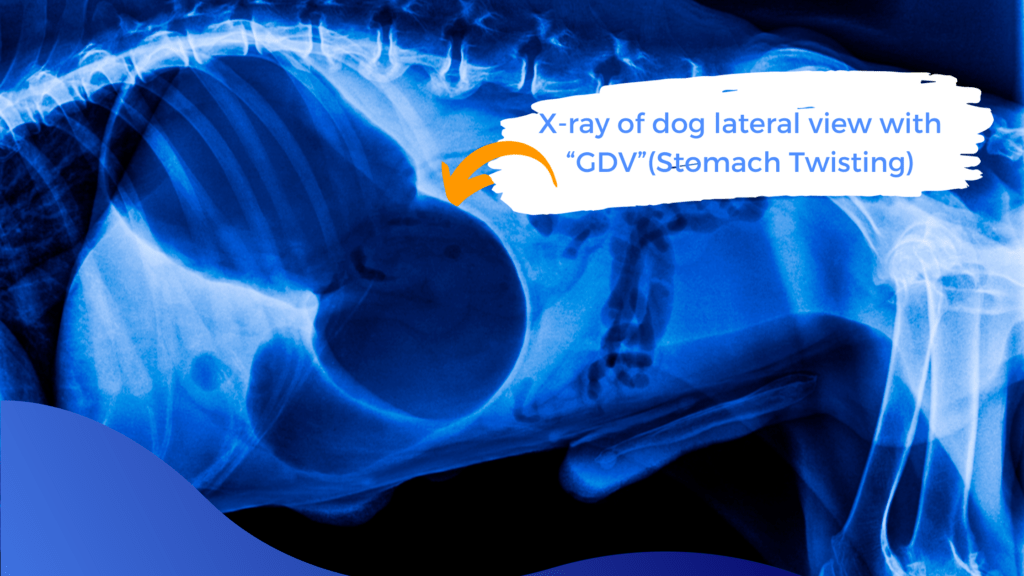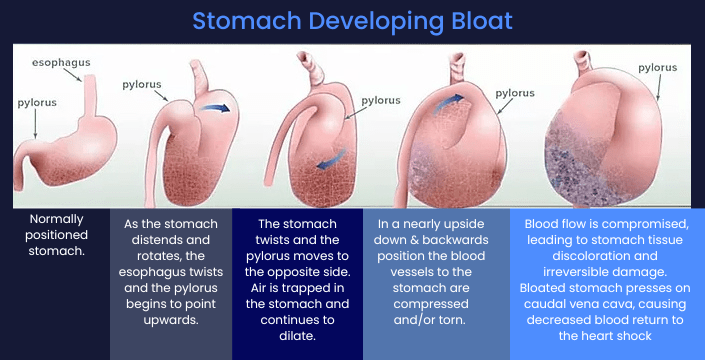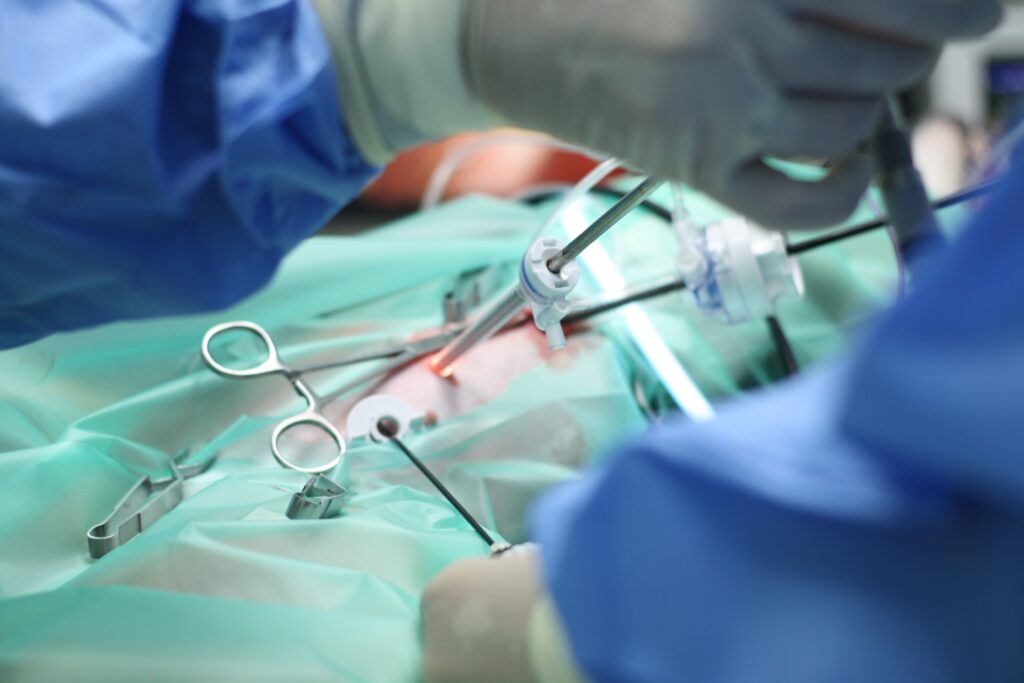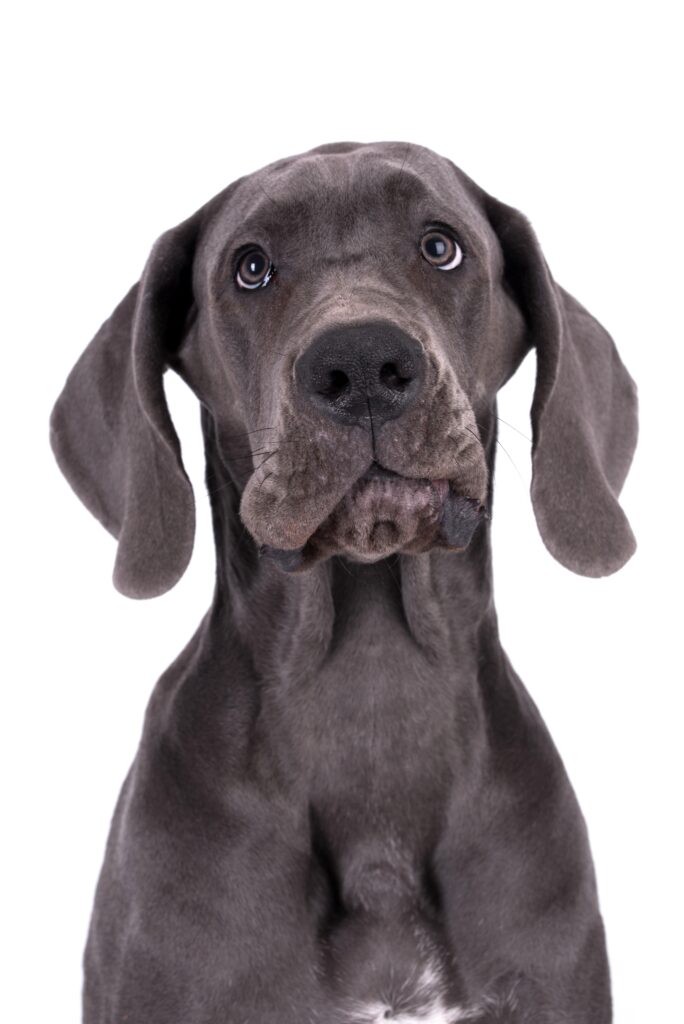
Gastropexy is a procedure that permanently attaches the stomach to the muscle wall of the abdomen, what would cause the need for this surgery? We explain all…
Gastropexy is a surgical procedure used in mainly large breed dogs to prevent gastric dilatation and volvulus, (GDV) also known as bloat. Gastropexy can be performed prophylactically in healthy dogs predisposed to GDV or as part of surgical management to prevent recurrence after the stomach returns to its normal position.
What Is Gastric Dilatation and Volvulus (GDV)?
Gastric dilatation and volvulus is a life-threatening condition primarily seen in deep-chested, large breed dogs like Great Danes, German Shepherds, Standard Poodles, Basset Hounds, Weimaraners, and Irish Setters.
With GDV the stomach becomes dilated with gas and or fluid and twists on itself, meaning that the gas or fluid cannot escape. This will then cause pressure and decreased blood flow to stomach tissues. In some cases, the spleen can also get twisted, compromising its blood supply. This can lead to gastrointestinal tract and spleen death, affecting blood pressure and overall health. Without emergency treatment, GDV is fatal.

“Published with permission from VIN® & Veterinary Partner® https://veterinarypartner.vin.com.”
What Are The Symptoms Of GDV?
- Distended Abdomen: The dog’s abdomen appears swollen or enlarged, often noticeably bloated.
- Unproductive Vomiting or Retching: The dog attempts to vomit but brings up little or no content.
- Abdominal Pain: The dog shows signs of discomfort when the abdomen is touched, such as whining or yelping.
- Restlessness and Agitation: The dog may pace, have difficulty finding a comfortable position, or exhibit signs of distress.
- Rapid or Shallow Breathing: Breathing may become labored due to the pressure on the diaphragm.
- Drooling and Excessive Salivation: The dog may drool more than usual as a result of nausea or discomfort.
- Weakness and Lethargy: The dog may become weak, lethargic, or collapse due to compromised blood flow.
- Pale Gums: The gums may appear pale or bluish, indicating poor circulation.
- Rapid Heart Rate: The dog’s heart rate may increase significantly as the condition progresses.
- Signs of Shock: As GDV advances, the dog may go into shock, displaying symptoms like cold extremities, a weak pulse, and a sudden drop in body temperature.
Immediate Action:
If you observe any combination of these symptoms, it is crucial to seek veterinary care immediately. GDV is a medical emergency that requires prompt intervention to save the dog’s life.
Recognising these symptoms and acting quickly can make a significant difference in the outcome for a dog suffering from GDV. If you suspect GDV, do not wait; contact your veterinarian or an emergency animal clinic immediately.
How Does A Gastropexy Prevent GDV?
Gastropexy involves a surgical procedure where the stomach is tacked to the right side of the body wall to prevent twisting and GDV. The most common technique involves creating incisions through the outer layer of the stomach and inside the body wall, exposing underlying bleeding tissue. The stomach is then sutured to the body wall using two lines of suture, allowing the exposed and bleeding tissue to contact each other.
Gastropexies can be performed laparoscopically or endoscopically (keyhole), using instruments and cameras inserted through incisions in the body wall or down the esophagus and stomach, but is less invasive and provides a faster recovery.

Two Indications For Gastropexy
Preventative:
Prophylactic Gastropexy -This is a gastropexy which is performed to prevent GDV, it is performed in high-risk young dogs, usually at the same time they are neutered or spayed.
Dogs with GDV:
Dogs with GDV require emergency surgery, to untwist the stomach and secure it, reducing recurrence risk from 55% to 4%.
Breed-rated 10-Year Risk
- Bloodhound 39%
- Great Dane 36.7-53%
- Irish Wolfhound 26%
- Poodle 25.3%
- Akita 25%
- Irish Setter 24.9%
- Collie 21%
- Weimaraner 19.1-21%
- German Shepard 17%
- Newfoundland 10%
- Rottweiler 3.9%
Other at-risk breeds
- Bernese mountain dog
- Boxer
- Doberman
- Golden Retriever
- Labrador Retriever

What Age Should You Consider a Gastropexy for your Dog?
At the Time of Spaying/Neutering: For many dogs, especially those identified as high-risk breeds, a gastropexy is often performed at the same time as the spay or neuter surgery. This is typically around 12 months of age.
Breeds with High GDV Risk: For breeds with a particularly high risk of developing GDV, such as Great Danes, German Shepherds, and Standard Poodles, some veterinarians recommend performing the surgery as early as possible, often around 6 months of age.
Individual Risk Assessment: Some veterinarians may prefer to assess the individual dog’s risk based on factors such as family history, body condition, and any prior signs of bloat. In such cases, the surgery may be timed accordingly.
Elective Surgery in Older Dogs: For dogs that were not given a gastropexy as puppies and are considered at risk, the procedure can be performed later in life. It’s important to discuss the benefits and risks with a veterinarian, especially for older dogs or those with underlying health conditions.
PRO’s
CON’s
Thanks for reading, until next time…
